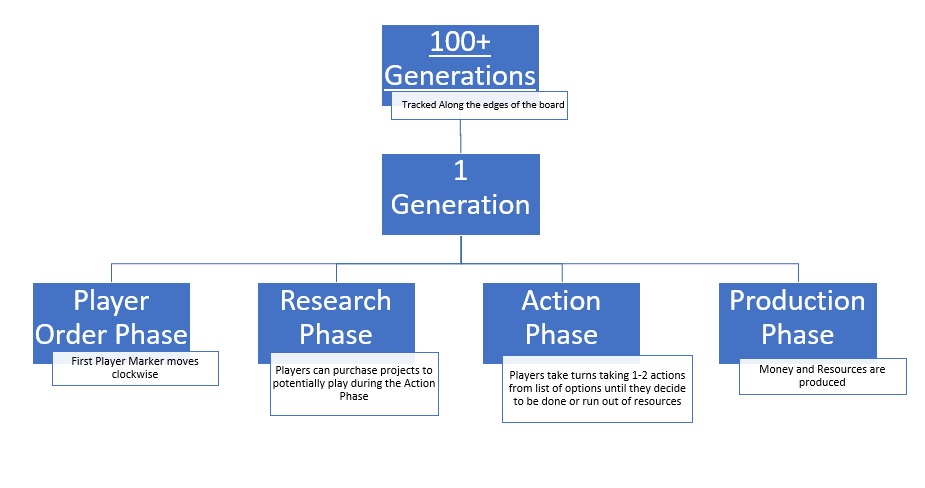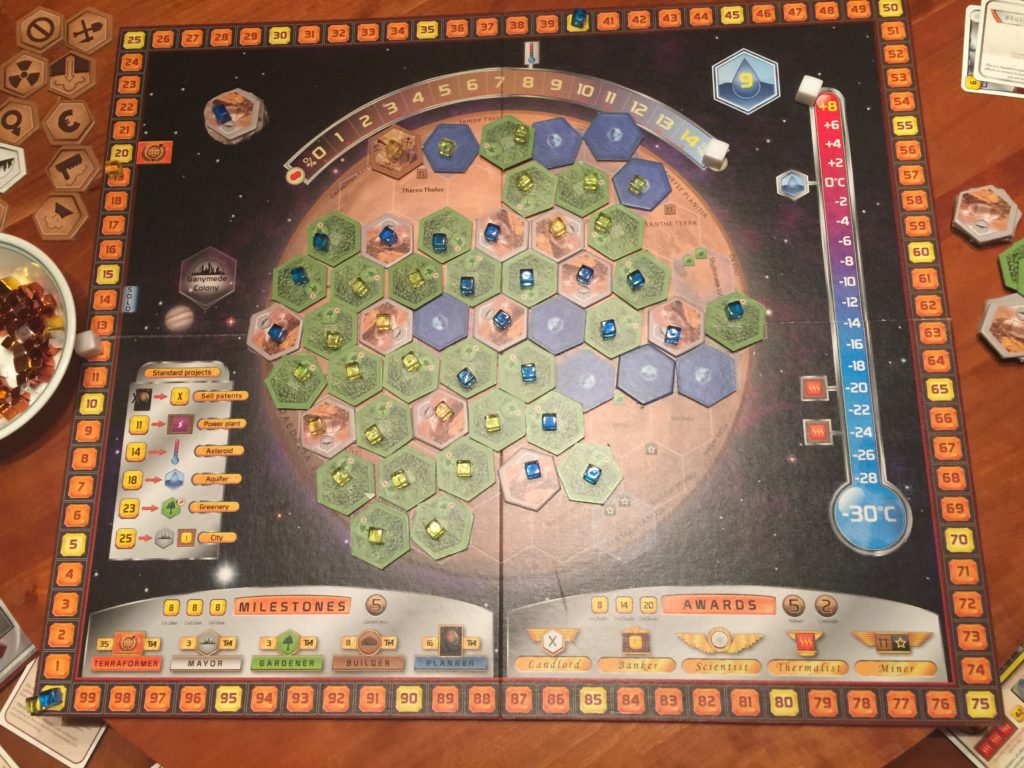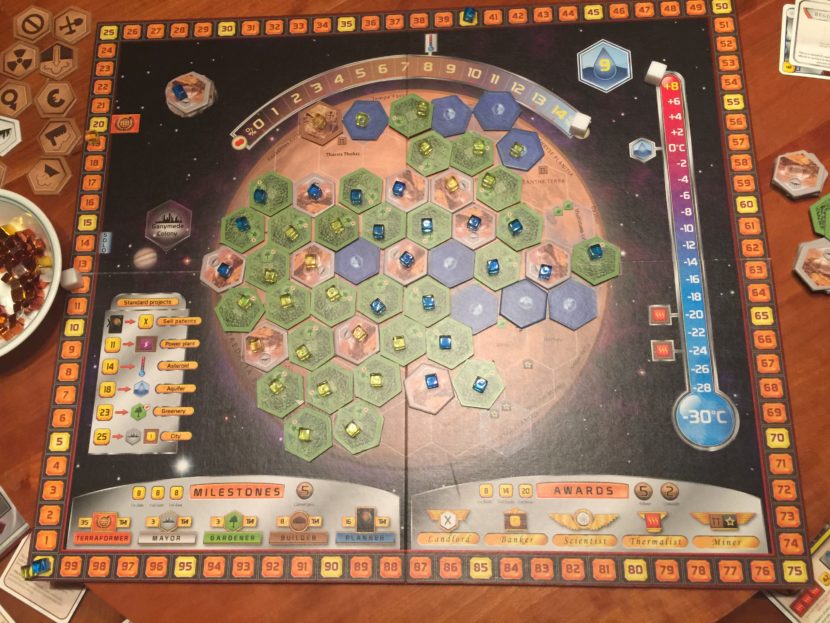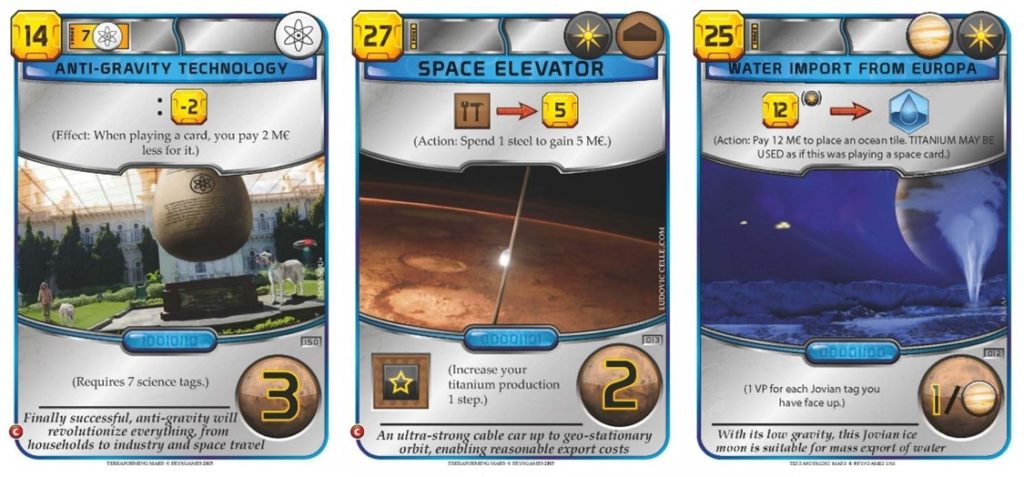Maria here again! If you are new here, my name is Maria, and I am Brandon’s wife! You can read my first post here. Brandon is humoring me with a mini game blog series where I give you MY perspective on board games. Last week, I received Marrying Mr. Darcy. This week, it’s Terraforming Mars. (That’s right – I’ve got range!)
Looking for more resources to help you on your board game design journey?
Here you go: no email required!
Like this writing style?
Check out my latest blog on marketing here.
I’m someone who grew up playing card and board games, but I would not consider myself a hobby gamer. I do have a cabinet of board games, but I didn’t really start accumulating games until after hitching my wagon to Brandon.
One of the very first board games that we received as a couple was Terraforming Mars, which we received from Brandon’s brother during our first Christmas together!
Just call me The Wall-E of Mars
Terraforming Mars has been out for a few years now, and it still stands as one of my favorite games. While the first game was beyond brutal, I have found the ever-evolving landscape to be loads of fun. (The rulebook seriously needs another 10 pages to it for potential scenarios, just saying).
Brandon is one of those gamers that thinks multiple moves ahead and it can be increasingly frustrating to play against him in a game of chess…BUT Terraforming Mars manages to work around that pesky habit of his quite nicely!
Side note: I feel like if we ever played chess, we could tell who’d win after the first two rounds.
Ok, enough chit chat. Let’s roll out and explore Mars!
Terraforming Mars: Board & Deck Building Game
Objective
Terraform Mars, duh. ALSO earn the most points by the end of the game. Per the instructions, “The game ends when there is enough oxygen to breathe (14 %), oceans enough to allow Earth-like weather (9), and the temperature is well above freezing (+8 ˚C). It will then be possible, if not comfortable, to live on the surface of Mars!”
Game Play Overview
One important thing to understand about the game is that we call rounds “generations.” Each Generation consists of four stages.
Setup
First, you select a character (corporation) from a selection where each has its own pros/cons. Each player gets specific startup resources based on their corporation.
Next, you set up the board according to the directions. The temperature and oxygen start as low as they can go. Each player starts with a set number of project cards. Then place character cubes on the starting Terraforming Rating space along the edge (#20).
The game then moves through 4 phases (the first generation doesn’t technically have the first two phases because those are conducted during setup).

Phase 1: Player Order
The Player 1 token circulates clockwise between generations. This is how the game makes sure everyone has a fair shot. For a 2-player game, this part can be difficult to remember to do, but it is important specifically for blue action cards that can only be used once per generation.
Phase 2: Research Phase
Everyone takes turns deciding if they want to “Research.” Research means you have the choice of buying cards. The cards are projects, which act as event cards you can play to get points and try to terraform Mars.

Phase 3: Action Phase – The Longest Phase
After everyone has conducted their “Research Phase” then the gameplay moves to the “Action Phase”. During your turn, you have a specific list of actions to choose from to complete during that turn. You then complete 1 or 2 actions each turn. You could even keep taking 1 or 2 actions until you run out of resources if you wanted to.
Once I realized that we could keep going as long as we wanted (essentially), I found a whole new element to the game that I enjoyed. Maybe this is standard for engine-building games, but it was a new concept to me. (It’s also probably is one of the reasons why I kept accidentally cheating.)
So as for your action options, you can choose to:
- Play a card from your hand
- Use a standard project (you pay money to do a project printed on the board)
- Claim a milestone (a side hustle to get extra points; you basically want to race to complete these first; printed on the bottom left of the game board)
- Fund an award (I’m still confused on these, but the idea is you are betting on yourself to be the best in whatever the award is; printed on the bottom right of the game board)
- Use the action on a blue card that you’ve already played (once per generation only)
- Convert 8 Plants into a Greenery Tile (which increases the oxygen 1% and therefore your Terraform Rating)
- Convert 8 Heat into a Temperature increase
Phase 4: Production Phase
Once everyone completes all the actions they want to (or, if you’re like me, you run out of money), then the “Action Phase” ends. At that point, the “Production Phase” begins. It is during Production that you get money!! And other resources too, blah blah blah.
Besides getting money, I like this phase because it really sticks to the concept that you are a company. Since I’m a tactile person, I particularly like getting to slide the “Energy” cubes over to the “Heat” section because energy converts to heat. Isn’t that neat?
After everyone has their money (and other resources) then the Player 1 token rotates, and you move to the next generation. I think the Generations are just a way to help keep track of who gets to go first and helps break up the phases/turns.
When just the two of us play, we only halfway remember to adjust the generation. We still try to keep up with the generations, though, because they are also important if you are using an action on one of the blue cards, since those can only be done once per generation.

Looking for more resources to help you on your board game design journey?
Here you go: no email required!
Like this writing style?
Check out my latest blog on marketing here.
What I love about Terraforming Mars
There is a lot to like about this game, so I’ll list them out:
There are just enough tactile elements to keep me interested. I love the different colored cubes and the dual-sided land pieces
Personally, I like the art on the cards. My husband is a bit more into game mechanics and the nitty gritty (can’t you tell I’m pleased I married a game developer? Ha!) and he thinks there are too many irregularities in the stock images and fonts. Honestly, I don’t care; the colors are bright so I’m happy.
I can be the Comeback-Kid! There are times where my husband has been absolutely clobbering me the entire game…until we go to tally up the points at the end of the game. Like Marrying Mr. Darcy, there are multiple ways to earn points. That means that even if you are majorly behind, you can still come back and win. Brandon still beats me a fair amount, but boy do I make him work for it!
True replayability. I feel like there are so many games out there that boast replayability, but don’t deliver. I’ll talk about the Forbidden games in a future post, but I feel like Forbidden Island is a good example of a game that technically can be played over and over again because the board always changes. But besides the changing board, there is not much else that changes.
With Terraforming Mars, however, you have a plethora of company options (each with their own bonuses and challenges) and even a whole second set of rules for added complexity. Brandon and I have been playing this game for years now and we still haven’t hit the tier 2 complexity cards.
Perfect 2-player game. Yup, I said it. I think that this is a perfect 2-player game. It will be interesting to see how it plays with more players, but it is complex enough for 2 people but also not one that requires thinking 12 steps in the future. Sure, you do still need to do some thinking ahead, but I draw the line at taking 20 minutes to plan out your next play. We aren’t all Doctor Strange, ok?

Could Use Improvement
The rule book desperately needs to be expanded. I realize that it can be challenging to write rule books and include every potential scenario, but there are some basic scenarios in the game that are not referenced anywhere in the rule book. Like the animals, ants, microbes, all that stuff. The cards do describe what to do, but there is no single page or section that outlines all the cards that interact with one another.
The first few times we played, I did not understand the relationship between a few of the cards because I only saw Card A and never saw Card B to understand the relationship. Make sense? Goodness, even trying to explain what needs to be improved is difficult…
Additionally, we need more resource cubes. Perhaps discs or some other marker to indicate a higher denomination (when you are producing in the double digits, the only current way to mark that is by stacking cubes)
We need more money cubes, too, but also more of the smaller denominations. If I could really get my way, then I would want the metallic look to not wear off.
Lastly, the game needs a box insert. I realize that there are separate inserts you can buy to put in the box, and we probably will go down that route one of these days. Even still, I wish that there was one developed by the board gamers that would then be able to remain on-theme. Then again, it is nice to help support some small business by buying the inserts from their etsy shops!
Preferred Game Mechanics: Very colorful, Incorporates a clicking noise, Tactile, but not needlessly fidgety (although a bit more fidgety than what I would like)
Board Game Geek Rating: 8.4 out of 10
We terraformed Mars…on to the next game
There you go! I hope you enjoyed my take on Terraforming Mars. If you are a patient person and willing to try something a little heavier than your normal game, then I highly recommend this game. There is a reason why it is so popular.
I’m going to go watch Wall-E now and do some Etsy shopping. I had *no idea* there were so many cute accessories to buy on Etsy for this game.
Next week I think I’m going to talk about a series of games that would be perfect for celebrating Halloween at home! At least, I know it’s what we are going to be doing 😀
Board Games, Seen By a Non-Gamer is written by Maria Polcari, Brandon’s wife. The series is meant to both make you think about games in a different way, and to give Brandon a much needed break!
This is the third in a five-part series (maybe more)!







2 thoughts on “Board Game Review: Terraforming Mars”
This review is extremely interesting to me because my wife and I run a YouTube channel (www.youtube.com/c/love2hate) where we try to bridge the gap between gamers and non-gamers. I’m a gamer and my wife isn’t, so we try to find games that we both enjoy, and not just gateway games, as though can tend to get stale for a lot of gamers. Your article really makes me consider trying to review Terraforming Mars. Thank you!
Hey, TM is easily my wife’s and mine favourite board game.
We found the boards and little cubes always ran out so I made this
https://steview-d.github.io/tm-score-app/
Feel free to use, I haven’t updated since I first built it, but it does the job.